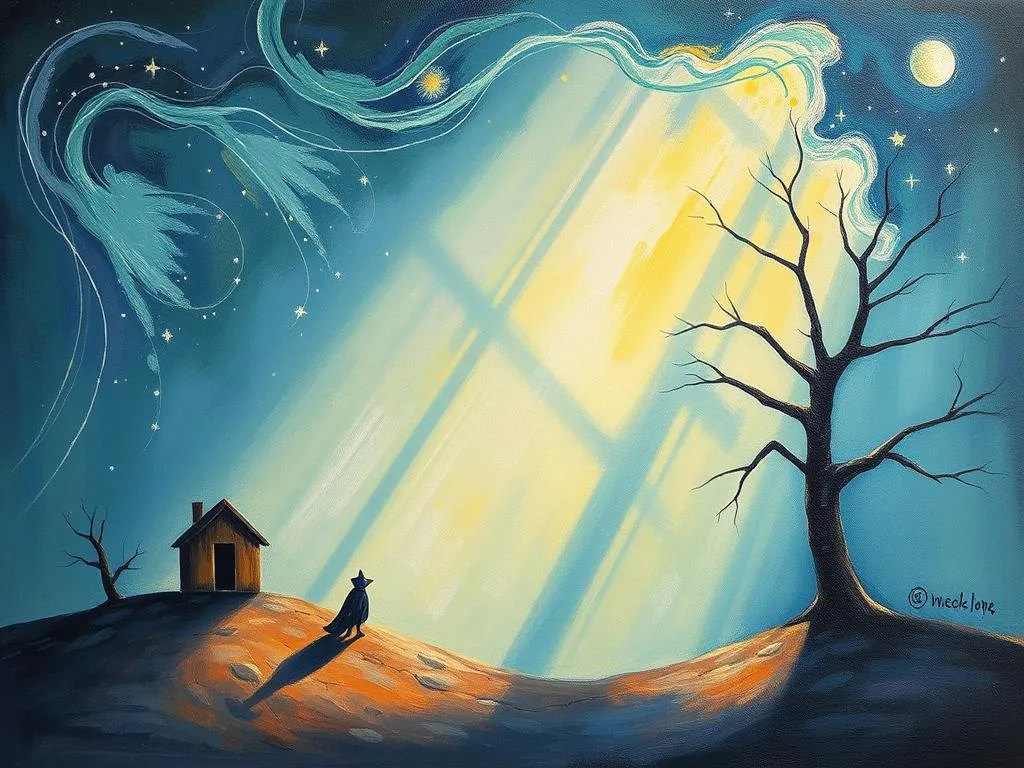
Dreams have long fascinated humanity, serving as windows into our subconscious. Among the myriad of dream symbols, big shadows often evoke a sense of mystery and unease. They can be interpreted in various ways, depending on the context of the dream and the feelings experienced during it. Understanding these shadows can be crucial for personal insight, as they may represent larger issues in our waking lives. In this article, we’ll delve into the symbolism and meaning of big shadows in dreams, explore key scenarios and variations, and connect these dreams to real-life situations for deeper understanding.
Symbolism and Meaning
The symbolism of shadows in dreams can be multifaceted. At their core, shadows often represent the unconscious mind, encompassing hidden fears, unresolved issues, or aspects of ourselves that we may be reluctant to confront. Big shadows can amplify these concepts, suggesting that there are significant matters looming over the dreamer.
In many cultures, shadows are linked to the idea of the unknown or the unseen. They can symbolize aspects of ourselves that we have yet to acknowledge. For instance, a big shadow might represent a fear of failure or anxiety about an upcoming challenge that feels overwhelming. This interpretation is particularly relevant when the shadow appears to be following the dreamer, suggesting an inability to escape from these fears.
Moreover, big shadows can embody external pressures or influences in our lives. They may indicate that we feel overshadowed by someone else’s expectations, such as a demanding parent, a competitive colleague, or societal norms. In this context, the shadow serves as a reminder to reclaim personal agency and confront these external pressures head-on.
From a psychological perspective, the big shadow may also signify a part of the self that has been repressed or denied. Carl Jung, a prominent figure in psychology, emphasized the importance of integrating the shadow self into our conscious identity. Dreams featuring big shadows could be inviting the dreamer to explore these neglected facets, encouraging a journey toward self-acceptance and wholeness.
Ultimately, the interpretation of big shadows in dreams is nuanced and deeply personal. The emotional tone of the dream, the dreamer’s waking life circumstances, and their unique psychological landscape will influence the specific meaning of such dreams.
Key Scenarios and Variations
The meaning of big shadows can shift dramatically based on the specific scenarios presented in the dream. For example, a dream where a big shadow looms over the dreamer while they are walking alone in a dark alley may evoke feelings of fear and vulnerability. This scenario could symbolize the dreamer’s anxiety about a precarious situation in their waking life, perhaps related to personal safety or the fear of the unknown.
Conversely, a dream in which the big shadow transforms into a comforting figure can suggest a different interpretation. Here, the shadow may represent a hidden strength or resource that the dreamer has yet to fully embrace. This transformation can symbolize growth and the integration of aspects of the self that were previously viewed as negative or threatening.
Another common scenario involves the dreamer trying to escape from a big shadow. This situation often resonates with feelings of avoidance or denial. It might indicate that the dreamer is attempting to escape from a significant issue rather than confronting it. This scenario encourages introspection, pushing the dreamer to identify what they are avoiding and work toward resolution.
In some dreams, the shadow may be associated with a specific person or figure. If the big shadow resembles a known individual in the dreamer’s life, it could symbolize the influence that person has over them. This may reflect feelings of inadequacy, comparison, or fear of judgment. Alternatively, if the shadow is faceless or amorphous, it may represent a generalized anxiety or fear that is difficult to pinpoint, suggesting a need for self-exploration to identify the source of these emotions.
Additionally, the dreamer’s actions in relation to the shadow play a critical role in interpretation. For instance, if the dreamer faces the shadow rather than fleeing, it indicates a willingness to confront their fears and challenges. This brave engagement suggests growth and a proactive approach to personal development.
Real-Life Connections and Takeaways
Connecting dreams of big shadows to real life can provide valuable insights and promote self-reflection. When a dream of a big shadow occurs, it can be beneficial for the dreamer to consider their current life circumstances. Are there areas of life where they feel overshadowed or overwhelmed? Are they avoiding certain responsibilities or emotions that need to be addressed?
One practical approach is to maintain a dream journal, where dreamers can record their dreams, noting their feelings and any recurring themes. This practice can help in recognizing patterns that may correlate with waking life experiences. Upon reviewing these entries, the dreamer may gain clarity about underlying issues, fears, or desires that require attention.
Additionally, engaging in self-reflection can prove invaluable. Dreamers can ask themselves thought-provoking questions such as: What does the shadow represent to me? Are there aspects of my life that I am ignoring? What fears or pressures am I currently facing? By exploring these questions, the dreamer can uncover deeper truths about themselves and their emotional landscape.
If the dreamer finds that the big shadow is connected to feelings of inadequacy or external pressures, it may be worthwhile to seek support from trusted friends or professionals. Discussing these feelings with others can provide new perspectives and help alleviate the weight of the shadow.
Moreover, practicing mindfulness and self-compassion can help in managing the emotions associated with these dreams. Techniques such as meditation or journaling can foster a sense of calm and awareness, allowing the dreamer to confront their fears without feeling overwhelmed.
Ultimately, big shadows in dreams serve as powerful symbols that encourage reflection and self-discovery. By recognizing and addressing the meanings behind these dreams, individuals can navigate their waking lives with greater clarity and confidence. Dreams are not merely random images; they are invitations to delve into the depths of our psyche and emerge with greater understanding.
In conclusion, whether the dreamer finds themselves grappling with a menacing shadow or embracing a transformative one, these dreams hold significant potential for personal growth. By exploring the symbolism and connecting it to real-life situations, individuals can harness the insights from their dreams to create positive change in their waking lives. Reflecting on the lessons learned from these nocturnal experiences can lead to a deeper understanding of oneself and a more empowered journey through life.







